As an Amazon Associate, we earn from qualifying purchases made through affiliate links.
You’ve fallen in love with a house. Not just any house—an old house, whether that be your dream, or for its location or its price. Taking on an old house for the first time is a true adventure not without its perils. Unknowns abound in all houses, even newer ones, from water in the basement to roof shingles that crumble at a touch. In an age of buyer beware, what’s to protect the newcomer?
Finding a house with a vintage pedigree that’s also well built, and which suits your budget and appetite for restoration, is a challenge. We’d rather you were armed with an assessment of the potential pitfalls.
This 1919 Sears bungalow was a wreck when the current owners bought it. Arts & Crafts bungalows tend to be pricey, so sweat equity is one way to get in on the ground floor. Gridley + Graves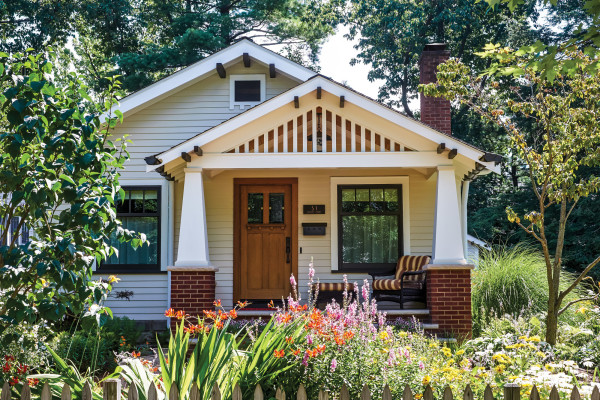
Use your instincts. Does the house “feel right” to you? Does it flow comfortably? As you look around, don’t be dazzled by fresh paint, or even a new kitchen. Be on the alert for warning signs, from cracks in an outer wall to uneven floors to damp or falling plaster. All of these issues are potentially complex and can be expensive to resolve.
After the offer and acceptance, get a thorough building inspection. Be there if you can. A good inspection can find many potential pitfalls that can either cost you immediately or further down the road.
While in some circumstances one or more of these may be deal breakers, in other cases, the solution is fairly straightforward. Something like asbestos-wrapped pipes, for instance, often will be addressed by the seller at minimal cost to you before closing. (A good real-estate broker should negotiate that for you.) That said, an inspection can’t cover everything. Many essential elements and critical failures can’t be seen without opening up walls, such as the source of an old leak or the current state of the electrical wiring.
As someone who has bought and sold six old houses (I’m living in the seventh), I wish I could tell you that I’ve anticipated every problem that could possibly crop up. Not even close. With every “new” old house, there was another unforeseen issue. My first house, a 1942 Cape Cod, presented my first experience with knob-and-tube wiring, which had to be completely replaced. On a moving deadline and in a hurry to find a house in a new town, my husband and I bought what we thought was a “safe” brick row house built in 1840, only to discover the brick was literally crumbling to dust on the back side where a window had been closed up.
Occasionally inspectors miss things. Our beloved 1923 Colonial Revival had a bad sill under the front door, but the inspector would have had to crawl 30 feet on his hands and knees to find it. (Needless to say, he didn’t.) The contractor who made the repair had opened the entire front façade down to the sheathing as a Category 5 hurricane bore down on our coastal town. Fortunately, the storm missed us and the house came through fine, thanks to stout sheathing composed of good old inch-thick solid boards, not modern MDF.
While I’ve learned something new from every old house I’ve owned, I still feel like a novice myself. So I research any potential issue beforehand, and have even paid for additional inspections when warranted. My current house (built in 1913) had a blocked chimney flue, wiring so shoddy that several fixtures are run out of original outlets, and a buried oil tank. We bought it anyway. For once, we got some unexpected good news: the underground tank has a cathodic protection system that prevents corrosion, so the tank won’t leak. Even though the inspection report says removal is “inevitable,” it should last for 25 more years.
Break out the champagne!
Shingles that are pockmarked and deteriorating are at the end of their useful life, and should be replaced. Courtesy e3 Roofing & Remodeling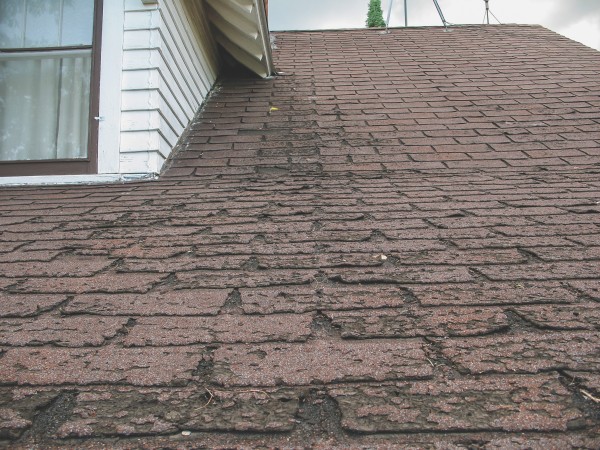
The Short List
- Will there be projects? Plan on it.
- Will I have to make the repairs myself? Not necessarily.
- Will I need extra cash after closing for those? Yes! At least 10 to 20 percent of the purchase price.
- What’s the best way to find good tradespeople? Word of mouth. Ask neighbors and anyone you talk to about a project, and check out community and historic-district bulletin boards online.
Big Ticket Items
Homebuyers whose interest in the exterior begins and ends with curb appeal have their priorities in the wrong place. Consider the envelope first before getting to the contents inside! Give the exterior your full attention, starting with the roof and continuing down to foundation and basement.
The Roof
The inspection report should specify the condition of the roof, and the years of useful life still left in it. Signs that an asphalt or shingle roof needs significant repair or replacement include missing or loose shingles; curled, cracked, or dry shingles; dark patches that indicate moisture penetration; excessive moss growth; missing or damaged flashing; a sagging roof line.
Which problems are deal breakers? It depends on whether the seller is willing to spot the cost of replacing or repairing the roof, or will only sell in as-is condition, meaning it becomes the buyer’s problem. Let’s say the house is on the small side, with 1,700 square feet of roof. Asphalt roofs typically cost about $3.50 to $5.50 per square foot to re-place. That translates to about $6,000 to $9,000 for that hypothetical small house. The tag for reroofing a house that’s twice as large could be up to $20,000. That’s a lot of pressure on a first-time buyer’s budget unless the asking price is low.
The stakes get even higher when the roof is clad in clay or concrete tile, or slate. Although these historic roofing materials can last 50 to 75 years or more, they become vulnerable when the supporting substructure begins to fail. Signs of wear include cracked, broken, or loose tiles, flaking or peeling tile (spalling), white efflorescence from water absorption, and metal failure on flashing and fasteners. If there are warning signs on 20% or more of the tiles, the roof has reached its tipping point and may need replacement.
For a first-time buyer on a budget, that failing roof can indeed be a deal breaker. Substructure repairs for these heavy and costly materials can be just as labor-intensive as laying completely new roofing. Replacement costs are double to three times as expensive as those for asphalt roofs ($9 to $15 per square foot or more). For our hypothetical small house, replacing that beautiful slate or clay roof could run $15,000 to $25,000. For a house twice as large, the ticket might be $40,000 or substantially more. Since the materials are less common than the ubiquitous asphalt shingle, it can be challenging to find a roofing contractor with the necessary skills to do the work, too.
As for homes with standing-seam or other types of metal roofs, the prognosis is a bit better. Metal roofs can last up to 100 years or more, provided they’re kept painted and free of rust. If the paint is peeling or beginning to rust, it needs attention. Hire a professional to clean and prep the roof, then coat it either with a metal-specific paint or an elastomeric coating. The process, of course, is not cheap, running between $1.35 and $1.85 per square foot, including labor. That translates to about $2,300 to $4,625 to
protect the roof with an elastomeric coating.
Knob-and-tube electrical wiring may still work, but it’s a safety hazard because the system is not grounded, and most codes don’t allow it to remain.
Electrical & Plumbing
Even if the house has 200-amp service, that does not meaning all the wiring in the house is up to code. In real-estate speak, many older houses have “mixed” wiring, from ungrounded knob-and-tube that predates World War II to aluminum wiring installed in the 1970s. If the inspection indicates that the wiring is a safety hazard, you are looking at a big-ticket repair, perhaps $20,000 or more to rewire the whole house.
When the “mixed” term is applied to plumbing, that means you’ll likely find everything from cast-iron waste or vent pipes and copper delivery lines to galvanized pipes and modern PVC. Low water pressure may be a sign that some of the older iron or galvanized pipes are corroded or blocked. While they may eventually need replacing, this presents less of a safety risk
Bowing beadboard on the porch ceiling is a sign that water is percolating in through the roof.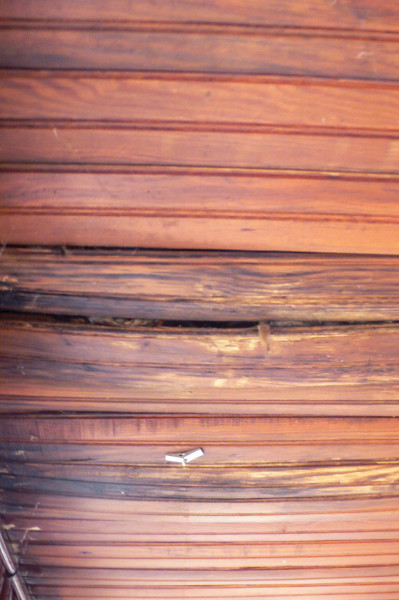
Siding + trimwork
As you approach the house for the first time, take a look at the porch and eaves. Is the wood sound, or are their signs of rot or deterioration, such as peeling paint, dirt, or mold? All are signs that the owner has let things go. Then look at the siding: have the shingles or clapboards been stained or painted recently? If the paint is peeling, blistering, or faded, that’s a sign of deferred maintenance. Look further: if the wood trim on the porch and under the eaves still appears to be mostly sound, and the clapboards do, too, the house is probably sound.
If the house is brick, check the mortar joints. Brick lasts practically forever, but mortar can deteriorate and usually needs repointing (a method of refilling missing material) every 60 or 70 years. Mortar that crumbles at a touch or is missing altogether in sections are warning signs that an extensive repair is needed.
Hazardous Materials
The most common hazardous materials found in older homes include asbestos, lead paint, radon, and mold.
Asbestos Because it is fireproof, asbestos is common in 20th-century building materials from exterior siding to vinyl asbestos tile. It is only dangerous when it’s deteriorating or disturbed—damaged, it releases microscopic fibers into the air, where they can be inhaled or swallowed. Exposure can cause lung cancer and mesothelioma.
Since many banks will not write mortgages on houses known to contain asbestos, the seller usually ends up paying for or crediting the cost of remediation. If the asbestos is prohibitively expensive to remove, it may be a deal breaker. Still, the house may be worth it, especially if the asbestos is sound and located where it can be left undisturbed.
When lead is present in paint, the best approach is professional removal. Courtesy Wikimedia Commons
Lead Paint Lead is common in household paint applied between 1922 and 1978. Like asbestos, it’s only dangerous when deteriorating. Unlike asbestos, a painted surface easily can be disturbed. (Test for lead paint with an instant-read kit, available at builder’s stores or online.) Lead paint can be encapsulated with paints and sealers specifically formulated for the purpose. If you were planning to paint anyway, however, consider professional removal, getting rid of the hazard once and for all. The pros wear protective equipment, including a NIOSH-certified respirator with a HEPA filter, and use only vacuum-attached power tools and low-heat removal methods, such as Eco-Strip’s Speedheater products. Should you decide to do the work yourself, follow the same protocols as the pros.
Because the material is so hazardous when disturbed, removing asbestos means wearing full body protection. Piman Khrutmuang / Adobe Stock (bkgrd)
RADON Radon is an invisible, odorless radioactive gas that occurs naturally in soil in locations all over the U.S. Radioactive particles filter up through ground sources such as unfinished basements and cracks in the foundation and walls. When inhaled, the particles can damage the cells that line the lung, potentially leading to lung cancer.
Your inspection report should include a radon report if you live in a radon-prone area. Radon levels in excess of 4 picocuries per liter are considered potentially dangerous. Although a test that comes back at that level or higher may be a deal breaker, there are ways to fix the problem. Request that the seller install vapor barriers over exposed soil in crawl spaces and basements, and seal leaks and cracks in foundation walls, then retest. (For more on radon, and a map of risk-prone areas, visit epa.gov/radon.)
MOLD Mold can be found almost anywhere moisture is present, proliferating on any household surface. It’s most harmful in areas that can’t be seen—in voids behind walls, inside HVAC ducts or cavities, or in attics or basements. Although many are harmless, toxic molds Stacybotrys chartarum, better known as black mold, and Memnoniella echinata should be addressed with the seller during consideration.
If the basement shows signs of water infiltration and mold, you may be able to remedy the problem by applying a waterproofing coating like UGL’s Drylok Extreme, which is guaranteed for 15 years. But look out for large cracks and movement.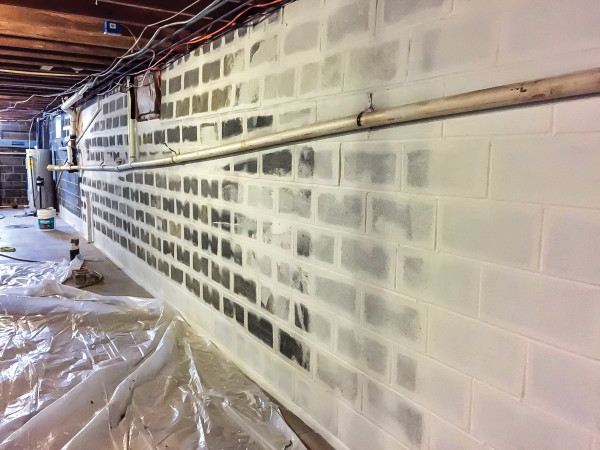
Basement & foundation
Many first-time buyers don’t even glance in the basement before making an offer. Big mistake! The basement is the best place to examine the structural integrity of the foundation, and to check for persistent wetness. A damp basement not only makes the house less pleasant to live in, but also sets the stage for mold growth and water penetration that can ultimately undermine the foundation. Minor dampness from water seepage can usually be fixed by applying a waterproof coating or installing a sump pump. But water that persists, especially after rain, indicates that something is wrong—gutters are plugged or missing, household appliances or the attic lacks proper venting, or most seriously, the ground around the foundation allows water to flow toward the house rather than away from it.
Although all of the issues above are fixable and probably not deal breakers, more serious damage down below is another story. Slumped or bulging walls with no evidence of repair, cracks that appear to be moving, spalling or efflorescence (surface delamination and white patches on stone or masonry) are all signs that water has been getting into the basement, probably for a long time. If the basement has one or more of these warning signs, it may be a deal breaker. Still interested? Your building inspector will refer you to a structural engineer. After you’ve paid hundreds (or even thousands) for an evaluation, the engineer may tell you everything looks fine—or issue an astronomical repair estimate.
Repairing a hole in plaster, using a three-coat system from Plaster Magic.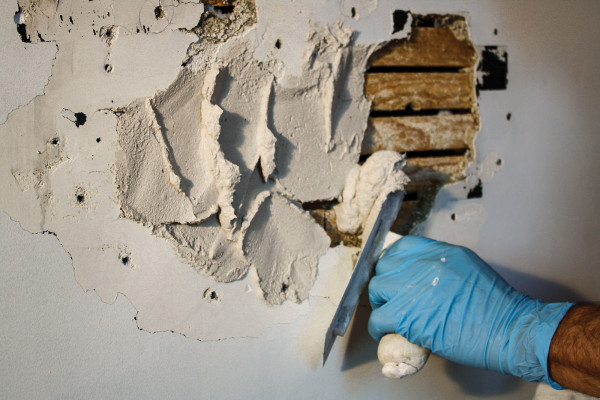
Failing plaster
If you find a house or apartment with real plaster walls, don’t be put off by a few cracks, holes, or other minor surface imperfections. Repairing small areas of damage is relatively easy (especially compared to drywall) and can give you your first experience with this versatile, long-lived material. Alarm bells should go off, however, if you see bulging walls or plastered areas so cracked or water-damaged that the material no longer holds firmly to the lath substrate. Pay special attention to the condition of plaster on upper floors. If there are signs of extension delamination (finish-coat failure) or key failure (where the plaster has detached from the underlying lath), repairs may be not only extensive, but also expensive. The cost of professional drywall installation in a 12′ x 12′ foot room, for example, will run between $1,000 and $1,600. While more desirable, professional plaster repair is even more expensive in many areas of the country.
Paul Smith of J.P. Chimney Services installs clay flue liners to extend the height of a 100-year-old chimney.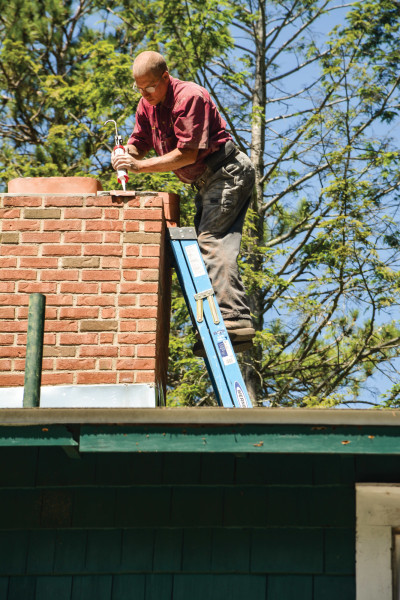
Fireplace & chimney
If it’s important to you that the chimney and fireplace be safe enough to use, hire an accredited chimneysweep to perform an inspection before the closing. (It usually isn’t part of the building inspection checklist.) The older the house, the more likely the chimney is to need work. Failed liners and flues blocked with rubble or bird’s nests are real fire hazards. Additionally, the firebox may lack firebrick, designed to withstand the repeated heating cycles in a fireplace. While all of these conditions can be remedied, sometimes they can’t be, at least without rebuilding the entire chimney. You may have to settle for gas logs, or accept that the fireplace is now merely decorative.
Buried oil tanks?
Buried steel oil tanks eventually rust, and leaks will pollute soil and groundwater. A simple removal costs $2,500–$4,000, but the price skyrockets if fuel has leaked. Remediation usually means digging up the area with a backhoe. If oil has made it to a nearby water body, things get expensive and potentially unresolvable. Add a contingency for removal and remediation to your contract with the seller.
Check the Flood Zone!
Flood-insurance rates are projected to rise in the next few years, so check the flood-zone status of any house under consideration. Some flood-prone areas include flood-zone status as part of real-estate disclosure information—but many don’t. FEMA flood-zone maps, detailed down to the individual parcel, are usually available online (look under the .gov for your town or county, then search tax parcel information). If you’d like to add on in a flood zone, you may be forced to raise the house above the base flood elevation. Raising even a small house costs $20,000 or more.







